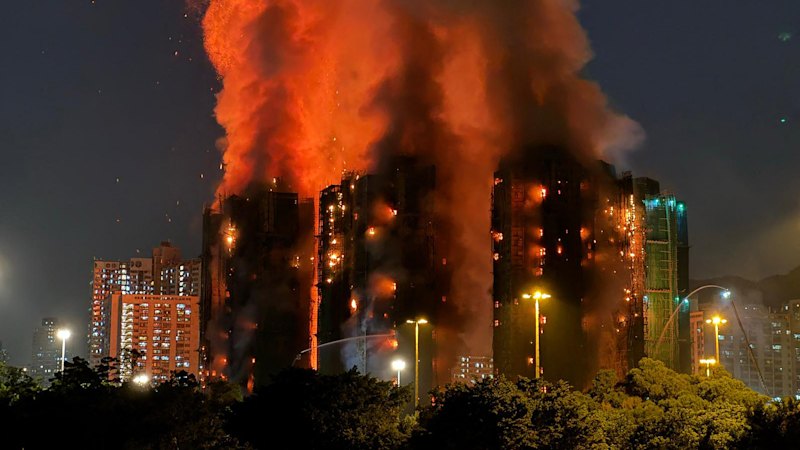
Hong Kong apartment fire in Tai Po puts bamboo scaffolding in spotlight
- [email protected]
- 0
- Posted on
Hong Kong’s leader John Lee said a task force had been set up to investigate the cause of the blaze.
Loading
“Buildings Departments’ independent review unit will investigate whether the building’s exterior walls meet the fire retardant standard,” he told a press conference.
“If there’s any wrongdoing we’ll pursue accountability in accordance with laws and regulations.”
Hong Kong secretary for security Chris Tang said preliminary investigations had found that the rapid spread of the fire was suspicious, Hong Kong’s South China Morning Post reported.
“We have found that on the relevant building walls, the netting and waterproof tarpaulin material, once burned, showed spreading of the flames faster than [they should on] regulated materials. This is unusual,” he said.
The city’s director of fire services Andy Yeung Yan-kin also said that officers had discovered styrofoam inside the burning buildings.

For decades in the skyscraper-strewn city, bamboo has been the material of choice for scaffolding.Credit: Anthony Kwan/Getty Images
He said that caused the fire to spread more rapidly within the blocks and ignite flats via the corridors, the Post reported. The fire chief said officers were only able to enter the buildings from the ground floor and that the number of floors that were on fire presented a major difficulty.
With 44 confirmed killed, the blaze is now the deadliest in Hong Kong in 63 years, surpassing the 1996 Kowloon fire in which 41 died in a commercial building.
The 44 deaths matches the number of people killed in a fire in the coastal Sham Shui Po district of Hong Kong in August 1962. That blaze started in an area where paper and joss-sticks were stored and then spread to fireworks, the South China Morning Post.
Lee on Thursday said the Hong Kong government would take special action against ongoing projects, checking whether scaffolding mesh materials meet fire retardant standards and other safety standards.
In March, the government said 50 per cent of new public works contracts would be required to use metal scaffolding going forward.
But the emphasis appeared to be more on worker safety rather than fire risks. There were 22 deaths involving bamboo scaffolders between 2019 and 2024, according to official figures.
Despite the safety push, Hong Kong’s secretary for labour Chris Sun said in July that “the government has no intention to ban the use of bamboo scaffolds at the moment”.
In October, a massive bamboo scaffolding caught fire at the Chinachem Tower in the Central business district. Again, fire consumed construction netting and bamboo poles, leaving windows burnt out and external walls badly seared.
The Association for the Rights of Industrial Accident Victims in Hong Kong said in a Facebook post that there had been at least two other fires involving bamboo scaffolding this year.
Protective nets, screens and tarpaulin or plastic sheeting installed on the face of scaffolding “should have appropriate fire retardant properties in compliance with a recognised standard”, says the Hong Kong Labour Department’s Code of Practice for Bamboo Scaffolding Safety.
Jason Poon, a whistle-blower who has previously exposed shoddy construction work in Hong Kong, said in a Facebook post on Wednesday that fire hazard risks existed in scaffolding at many housing complexes.
He said he had reached out to various government departments last year concerning the lack of fire retardant in scaffolding nets at another complex, but he was ignored. Reuters received no immediate response from the fire, buildings and labour departments to a request to comment.
Reuters